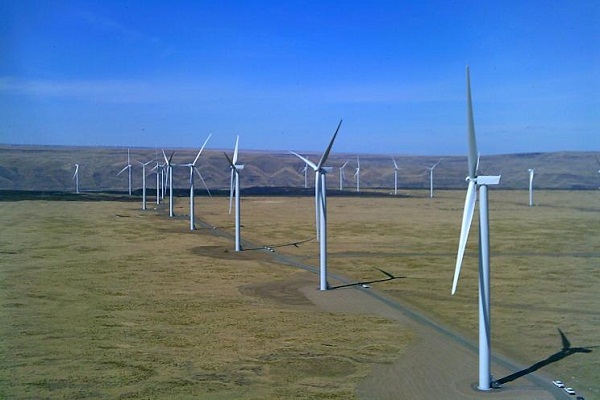With the pending expiration of the production tax credit for wind threatening to put the kibosh on new projects, the nation’s second-largest wind farm, an array of 338 turbines scattered over thousands of acres of wind-buffeted hills just south of the Columbia River in north-central Oregon, officially began full operations on Saturday.
Along with cheers from renewable energy advocates, the completion of Caithness Shepherds Flat brought reminders of the heavy subsidies that supported its development — and, ironically, highlighted the gloomy state of the wind industry in the United States in the waning days of the PTC.

This 845-megawatt Oregon project has been coming online in increments, sending power under 20-year agreements to Southern California Edison and helping the utility meets its obligations under California’s aggressive renewable portfolio standard. With the entire project finished, Caithness Energy, politicians and assorted partners in the project – including Google, which invested $100 million — did the ribbon-cutting thing.
In doing so, they called Shepherds Flat “one of the world’s biggest wind farms,” apparently not interested in picking a fight with the Alta Wind Energy Center in California, which checks in at 1,020 MW (and growing). Alta has several units, and some people apparently don’t want to add them all together and call it the biggest wind farm, and instead give that title to Shepherds Flat. But Shepherds Flat itself is made up of three units was built in three blocks, according to the Oregon Department of Energy: Shepherds Flat North (265 MW), which was completed in February; Shepherds Flat South (290 MW), completed in July; and Shepherds Flat Central (290 MW), where work was wrapped up in August.
Anyway, they both seem to lose out to Jaisalmer Wind Park in India, which reportedly reached 1,064 MW in April.
What might truly distinguish Shepherds Flat is the level of taxpayer support it received. Even within the Obama administration there was concern expressed on this count: An October 2010 memo to President Obama by three senior White House advisors detailed how developers were able to pile several different subsidy programs into a mountain of benefits that left them with “little skin in the game.”
The memo noted that Shepherds Flat’s developers received a $500 million federal grant, state tax credits totaling $18 million, accelerated depreciation on federal and state taxes worth $200 million, and a premium for its power from the state worth $220 million. On top of that, a $1.3 billion partial loan guarantee provided $300 million in benefits to the developers, bringing the total subsidy for the $1.9 billion project to nearly $1.24 billion. The memo speculated that the project would have happened without the loan guarantee.
In celebrating the project’s completion, however, the developers and supporters said the support Shepherds Flat received was well worth it. They put the focus on the project’s benefits – and even Greg Walden, Oregon’s lone Republican in its House delegation and a favorite of Speaker John Boehner, was on board.
“This project has created jobs during a very tough time for rural areas of Oregon, and has added to the tax base as counties are struggling to provide basic services,” Walden said in a statement. “Moreover, the wind energy produced at Caithness Shepherds Flat will be part of an ‘all of the above’ energy strategy that this country so desperately needs.”

Caithness Energy said Shepherds Flat “will eliminate 1.483 million metric tons of CO2 annually, the equivalent of taking approximately 260,000 cars off the road.” The company said the turbines will spin out “an estimated 2 billion kilowatt-hours each year,” equivalent to the total used by 173,000 average Oregon homes annually. Some 400 workers were on the job building the wind farm for more than two years, and 45 workers will be employed operating and maintaining it.
Shepherds Flat apparently took advantage of the investment tax credit cash grant instead of the production tax credit for wind. But the cash grant option for the investment tax credit is gone, and without Congressional action in the lame-duck session later this year, the PTC will be, too, for projects not completed by the end of the year. Job losses are already mounting throughout the industry supply chain, and the American Wind Energy Association predicts the expiration of the PTC could result in the loss of 37,000 jobs.